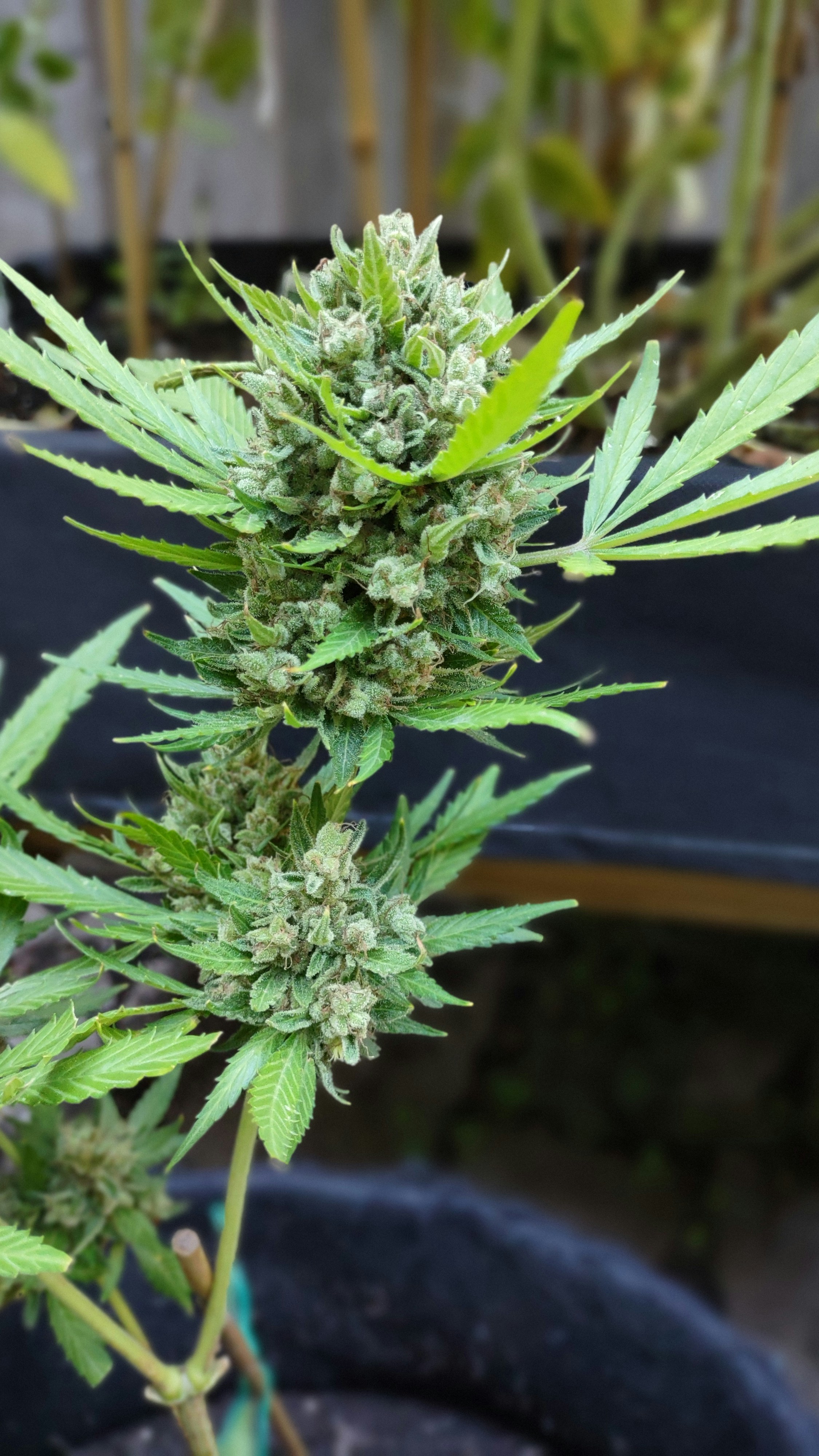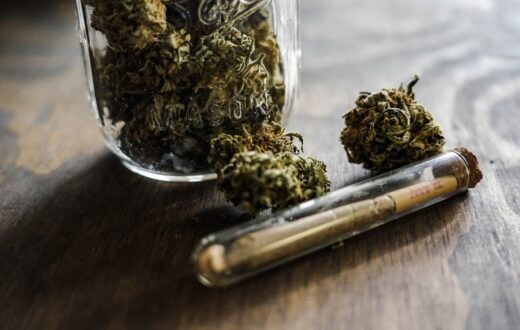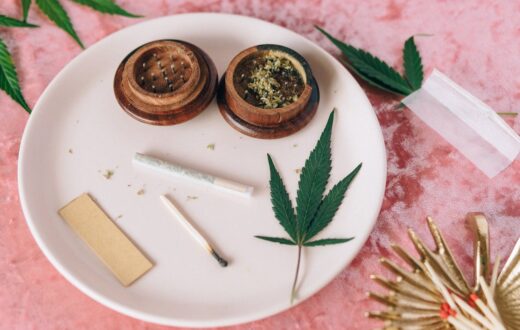Introduction to Bubba Kush
Bubba Kush is a renowned indica-dominant cannabis strain that has garnered a dedicated following among both recreational and medicinal users. Its origins can be traced back to the mid-1990s, specifically within the Los Angeles cannabis scene. Often credited to a combination of the strains Northern Lights and an unknown Afghan variety, Bubba Kush has successfully maintained its reputation due to its unique effects, robust flavor profile, and ease of cultivation.
One of the key characteristics that differentiate Bubba Kush is its potent effects, appealing especially to those looking for relaxation and relief from stress. Users often report a heavy body high complemented by an uplifting euphoria, making it a favored choice after a long day. Additionally, Bubba Kush is recognized for its ability to alleviate various ailments, including chronic pain, insomnia, and anxiety, thus making it a popular choice among medical cannabis users.
The flavor profile of Bubba Kush is equally notable, boasting a rich and complex blend of coffee, chocolate, and earthy undertones. These flavor notes translate well into the cultivation process, as growers appreciate the strain’s high resin production and the earthy aromas that fill the grow room during flowering. An important aspect for novice cultivators is that Bubba Kush is relatively easy to grow, making it an accessible choice for those learning how to grow Bubba Kush weed strain. Its robustness allows it to thrive in various environments, contributing to its widespread popularity.
In summary, Bubba Kush stands out not only for its potent effects and delightful flavors but also for its overall appeal in the cultivation world. Its origins and distinctive qualities make it a staple in the cannabis community, encouraging many to explore its cultivation.
Understanding the Growing Environment
To successfully cultivate the Bubba Kush weed strain, understanding its optimal growing environment is crucial. This strain thrives in specific temperature and humidity ranges that favor its robust genetic makeup. The ideal temperature for growing Bubba Kush typically falls between 70°F to 85°F (21°C to 29°C) during the day, with a slight dip at night to about 60°F (15°C). Maintaining these temperatures can prevent stress in the plants and promote healthy growth.
Humidity levels play an equally notable role in the development of Bubba Kush. During the vegetative stage, a relative humidity level of 40% to 70% is optimal. In contrast, as flowering begins, it is advisable to decrease humidity to around 40% to 50%. This reduction helps to minimize the risk of mold and mildew, which can be detrimental to the health of the plants.
Light conditions are another fundamental aspect to consider when learning how to grow Bubba Kush weed strain. This strain flourishes under a light cycle of 18 hours of light and 6 hours of darkness, especially during the vegetative phase. Once transitioning to the flowering stage, a 12/12 light cycle is recommended to trigger the necessary hormonal changes for bud formation. Utilizing high-quality LED or HPS grow lights can enhance the plants’ growth rates and yield.
The choice of soil is paramount for Bubba Kush, as it prefers well-draining, nutrient-rich soils. A mix containing organic compost, perlite, and peat moss can create an ideal growing medium. This combination ensures that the roots receive the essential nutrients while fostering healthy drainage. Regular feeding with balanced fertilizers designed for cannabis will further support the plants, enhancing their growth and overall vigor.
Choosing the Right Seeds
When embarking on the journey of how to grow Bubba Kush weed strain, the selection of quality seeds is a fundamental step that can significantly impact the overall success of your cultivation. The seed type you choose should be informed by your growing preferences and environmental conditions. There are three primary types of seeds: regular, feminized, and auto-flowering.
Regular seeds contain both male and female plants, allowing you to breed new strains or produce seeds for future grows. However, they require careful monitoring to ensure the male plants do not pollinate the females, which could result in seeded buds. Feminized seeds, on the other hand, produce only female plants, making them an excellent choice for novice growers seeking a straightforward process. These seeds are specifically bred to eliminate male chromosomes, thus increasing the likelihood of a bountiful yield without the need for sexing plants. Lastly, auto-flowering seeds are ideal for growers looking for a rapid turnaround, as they flower based on age rather than light cycles, allowing you to harvest sooner.
When selecting your Bubba Kush seeds, it is crucial to source them from reputable seed banks. Established companies often provide information on genetic lineage and cultivation tips, ensuring you acquire healthy seeds. Additionally, check for reviews and customer feedback to guarantee a reliable source of quality seeds. It’s advisable to consider factors such as seed viability, which can be tested by soaking them before planting. This process helps verify if the seeds are suitable for growth. Ultimately, the choice of seeds plays a critical role in how to maximize your success when growing Bubba Kush weed strain, ensuring you start with the best foundation possible.
Germination Process
Germination is a pivotal step when learning how to grow Bubba Kush weed strain, as it sets the foundation for healthy plant development. Successful germination involves activating the seeds, allowing them to sprout and rapidly develop roots. Here are the effective methods to germinate Bubba Kush seeds.
One common technique is the paper towel method. This approach is both straightforward and effective. Begin by moistening two paper towels, ensuring they are damp but not dripping wet. Place the seeds evenly on one of the towels and cover them with the second towel. Then, place the setup inside a plastic bag or container to create a humid environment. The seeds should remain in a dark location, ideally at room temperature. After a few days, you should start to see the seeds sprouting, which indicates that germination has occurred.
Alternatively, soaking the seeds is another effective method. Start by placing the seeds in a small glass of water, ensuring they are fully submerged. Leave them to soak for approximately 12 to 24 hours; this will help to soften the seed coating and kickstart the germination process. After soaking, the seeds can be transferred to a growing medium, such as soil or a seed starter mix. It’s important to plant them about a quarter to half an inch deep, ensuring that the pointed end of the seed is facing downward.
To enhance germination rates for Bubba Kush weed strain, maintain optimal moisture and temperature conditions. A warm environment, ideally around 70-85°F (21-29°C), will significantly improve the likelihood of successful germination. Covering your germination setup with a plastic wrap can help retain moisture, creating a suitable microclimate. Patience is key; monitor your seeds regularly and avoid over-watering, as damp conditions can lead to mold growth. By following these methods and tips, you will increase the chances of successfully germinating Bubba Kush seeds.
Vegetative Stage Care
The vegetative stage is a critical phase in the growth of the Bubba Kush weed strain, as it lays the foundation for a healthy and bountiful harvest. During this stage, which typically lasts for 4 to 8 weeks, it is essential to focus on watering schedules, feeding routines, and light exposure to nurture the plants effectively.
When it comes to watering, Bubba Kush has specific moisture requirements. It is important to water the plants deeply but less frequently, allowing the top inch of soil to dry out before the next watering session. Overwatering can lead to root rot, while underwatering can stall plant growth. A good rule of thumb is to monitor the soil daily to check its moisture level. Additionally, it is advisable to use filtered or distilled water to avoid chemicals that could affect the plant’s health.
Nutrient management is also crucial during the vegetative stage. Bubba Kush thrives on a balanced feeding regimen, typically requiring a higher nitrogen content to promote robust foliage development. Growers should opt for a high-quality fertilizer specifically designed for the vegetative phase. It is typically recommended to feed the plants every two weeks, gradually increasing nutrient strength as the plants grow taller and their needs change.
Light exposure is another pivotal element to consider. Bubba Kush prefers 18 to 24 hours of light per day during the vegetative stage. Implementing a light cycle that provides ample hours of bright light will help stimulate vigorous growth. Some growers find that utilizing LED lights can enhance growth while conserving energy. Moreover, training techniques such as topping, low-stress training (LST), and pruning can significantly improve light penetration to lower branches, promoting an even canopy and harnessing the full potential of the Bubba Kush strain.
By adhering to the right watering schedules, feeding routines, and light exposure techniques, cultivators can set the stage for a successful and fruitful harvest of the Bubba Kush weed strain.
Flowering Stage Techniques
The transition into the flowering stage is a pivotal moment in the growth of the Bubba Kush weed strain. This phase commences when the light cycle is adjusted to signal the plants that it is time to produce flowers. Typically, growers will reduce light exposure from 18 hours per day to 12 hours. This alteration mimics the natural fall season, leading to the commencement of flowering. It is essential to adhere to this schedule diligently, as consistent light cycles can significantly influence yield and flower quality.
During the flowering stage, it is vital to provide the right nutrients to the Bubba Kush weed strain. This strain, known for its rich and dense flowers, thrives on a nutrient regimen that is higher in phosphorus and potassium as compared to nitrogen. Growers should switch to fertilizers specifically designed for the flowering phase, which will aid in optimizing bud development. Ensuring proper pH levels in the nutrient solution, ideally between 6.0 and 6.5, is crucial to prevent nutrient lockout and promote healthy growth.
Pest management also becomes increasingly important during this stage. The flowering plants are sensitive and can attract various pests, including spider mites and aphids. Regularly inspecting the plants will help in early detection of any infestations. Utilizing organic pesticides or introducing beneficial insects can effectively manage pests while keeping the plants healthy. Additionally, identifying male plants in feminized crops is necessary to avoid pollination. Male plants should be removed immediately, as their presence can compromise the quality of the buds. Understanding how to grow Bubba Kush weed strain effectively involves a balanced approach to light, nutrients, and pest management throughout the flowering period.
Signs that Bubba Kush is Ready for Harvest
Determining the optimal harvest time for Bubba Kush involves careful observation of several key indicators. The most critical sign is the development of the trichomes, which are small, hair-like structures on the buds. When these trichomes transition from clear to cloudy and amber, they indicate the plant’s maximum potency. A higher concentration of milky white trichomes typically signifies peak THC levels, while a greater presence of amber trichomes suggests that the cannabinoid content may start to decline, leading to a more sedative effect. It is advisable to monitor the trichomes closely with a jeweler’s loupe or a microscope to make an informed decision on when to harvest.
Cutting Techniques and Timing
Harvesting Bubba Kush requires precise timing and cutting techniques to ensure the preservation of its rich flavor and aroma. Ideally, it’s best to harvest during the late morning hours after the dew has evaporated from the plants. This practice helps to maintain the integrity of the terpenes, which are sensitive to moisture. When it comes to cutting the plants, always use sharp, sterilized scissors or shears to minimize stress and potential damage to the buds. It is recommended to cut the branches rather than individual buds, making the drying process more efficient and preserving the overall structure of the plant.
The Importance of Proper Harvesting
Proper harvesting of the Bubba Kush strain not only contributes to maximum yield but also enhances the overall quality of the end product. Neglecting the signs of readiness or using incorrect techniques can lead to diminished potency, flavor, and aroma. Therefore, growers should prioritize understanding the specific needs of the Bubba Kush plant, tailoring their approach based on individual growth conditions and genetics. A well-timed harvest can result in an exceptional product that showcases the true essence of the Bubba Kush cannabis strain.
Curing and Storing Your Yield
After harvesting Bubba Kush, the curing process is a crucial step to enhance the overall flavor, aroma, and potency of the weed strain. Curing involves a careful process of drying the buds to the ideal moisture content, followed by storing them in a controlled environment. Proper drying ensures that the flowers retain their natural oils and terpenes, which contribute to the distinctive characteristics of Bubba Kush.
To begin, hang the harvested buds upside down in a cool, dark, and well-ventilated area. It is essential to maintain a temperature between 60-70°F (15-21°C) and humidity levels around 45-55% during this phase. The drying process typically takes about 7 to 14 days, depending on the size and density of the buds. Monitor them closely, and when the outer leaves feel dry and the stems snap easily, it is time to proceed to the curing phase.
Curing involves placing the dried buds in airtight containers, such as glass jars, which should be filled only about 70% full to allow for air circulation. For the first week, open the jars several times a day for 5-10 minutes to release moisture and allow fresh air to circulate, a process often referred to as “burping.” After the first week, the frequency of burping can be reduced to a few times a week. The curing process can last anywhere from 2 to 8 weeks, with longer curing times generally yielding better flavors and effects.
Once your Bubba Kush has been adequately cured, long-term storage becomes paramount to maintaining its quality. Store the jars in a dark, cool place, away from direct sunlight and temperature fluctuations. Vacuum sealing and avoiding exposure to air will also help preserve the strain’s potency and freshness over time. Adhering to these methods will ensure that your yield of Bubba Kush remains effective and enjoyable for months to come.
Common Issues and Solutions
Growing the Bubba Kush weed strain can be a rewarding experience, but it is not without its challenges. One of the most frequent issues faced by cultivators is pest infestations. Common pests, such as spider mites, aphids, and whiteflies, can wreak havoc on cannabis plants. To combat these invaders, regular monitoring is essential. Employing organic pesticides, introducing beneficial insects like ladybugs, and practicing good sanitation can greatly reduce pest populations. Additionally, maintaining optimal environmental conditions can deter pests from becoming a significant problem.
Nutrient deficiencies are another common challenge when cultivating Bubba Kush. This strain is particularly sensitive to imbalances in nitrogen, phosphorus, and potassium levels. If leaves exhibit yellowing, browning, or curling, growers should carefully assess their nutrient regimen. Conducting soil tests and adjusting the feeding schedule based on the specific growth stages of the plants can help restore balance. Utilizing high-quality fertilizers that are designed for cannabis can also minimize the risk of deficiencies and promote healthy growth.
Environmental factors play a crucial role in the successful cultivation of Bubba Kush. Fluctuations in temperature and humidity can lead to stunted growth or even mold issues if not properly managed. Ideally, the daytime temperature should be maintained between 70-85°F (21-29°C), while nighttime temperatures should not drop below 60°F (15°C). Monitoring humidity levels is equally important; they should ideally remain between 40-60% during the vegetative phase, dropping to 40-50% during flowering. Employing dehumidifiers, fans, and proper ventilation can significantly enhance climate control, providing a suitable environment for healthy Bubba Kush plants.
By anticipating and addressing these common issues, growers can achieve a successful yield of Bubba Kush weed strain, ensuring their plants stay vibrant and vigorous throughout their growing cycle.












